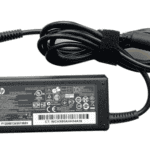Crypto mining is the process where people use computers to verify transactions on blockchain networks like Bitcoin. They solve math problems to secure the network and earn cryptocurrency as a reward. This process needs powerful computers and lots of electricity, which is why some miners set up large operations in places with cheap power.
The mining hardware ranges from basic home computers to specialized machines called ASICs (Application-Specific Integrated Circuits). ASICs are built for one task – mining specific cryptocurrencies. They work much faster than regular computers but cost more upfront and can only mine certain coins.
When buying mining equipment, focus on three key factors: hash rate (how fast it solves problems), energy efficiency (electricity used per hash), and price. A good miner balances these factors to maximize profit. The right choice depends on electricity costs in your area, the cryptocurrency you want to mine, and your budget for equipment.
Crypto mining has changed a lot since Bitcoin started in 2009. In the early days, people could mine Bitcoin using regular home computers. Today, most profitable mining requires specialized equipment and low electricity costs.
Mining works through a process called Proof of Work. Miners compete to solve complex math problems. The first one to solve it gets to add a new block of transactions to the blockchain and receives new coins as a reward. This system makes sure everyone agrees on which transactions are valid without needing a central authority.
Most miners join mining pools to increase their chances of earning rewards. In a pool, many miners work together and share the rewards based on how much computing power each person contributes. This gives miners more regular income compared to mining alone.
The equipment needed varies by cryptocurrency. Bitcoin mining now requires ASIC miners that cost thousands of dollars. Other coins like Ethereum Classic can be mined with powerful graphics cards (GPUs). Some newer cryptocurrencies use different systems that don’t need expensive equipment or much electricity.
Electricity costs often determine if mining will be profitable. In countries with cheap electricity like Iceland or parts of China, large mining farms have been built. These operations run thousands of miners at once to maximize profits through scale.
Mining’s environmental impact has become a hot topic. The Bitcoin network alone uses more electricity than some small countries. This has led to calls for more energy-efficient mining methods and use of renewable energy sources.
Best Crypto Mining Equipment
Our list of top crypto mining equipment helps beginners and experts find the right tools. These products offer different levels of power and efficiency for mining Bitcoin, Ethereum, and other cryptocurrencies. We’ve selected options that balance performance, energy use, and cost to fit various mining needs.
Cryptocurrency Mining For Dummies

This comprehensive guide offers valuable information for beginners wanting to understand crypto mining without overwhelming technical jargon.
Pros
- Clear explanations of complex mining concepts
- Updated content in this second edition
- Includes practical steps to start mining
Cons
- Some information becomes dated quickly
- Lacks advanced strategies for experienced miners
- Limited coverage of newest mining technologies
The book breaks down the basics of cryptocurrency mining in simple terms. Readers learn about blockchain technology, different mining methods, and how to set up mining equipment. The author explains difficult concepts using easy-to-understand examples.
With 352 pages of content, this guide covers everything from selecting hardware to joining mining pools. The second edition updates information about mining profitability and energy consumption. The book also discusses cryptocurrency security and storage options for your digital earnings.
Many readers appreciate how the book explains the economics of mining. It helps newcomers understand the costs involved before investing in expensive equipment. The For Dummies series maintains its reputation for making complex topics accessible to beginners with this mining guide.
Readers should note that cryptocurrency technology changes rapidly. Some specific recommendations about hardware or software might need updating. Still, the core concepts and mining fundamentals remain valuable for anyone exploring this field.
Cryptocurrency All-in-One For Dummies

This comprehensive guide is an excellent starting point for anyone interested in understanding cryptocurrency from basics to advanced concepts.
Pros
- Combines six books in one, offering extensive coverage
- Easy to understand explanations of complex topics
- Includes helpful resources throughout
Cons
- Large book at 816 pages may overwhelm beginners
- Some readers reported receiving damaged copies
- Information may need updating as crypto evolves
The Cryptocurrency All-in-One For Dummies delivers much more content than most readers expect. Many users who had previously read other books on cryptocurrency found that this single volume replaced their need for multiple resources. The book breaks down complex concepts into simple terms that even complete beginners can understand.
At 816 pages, this guide covers everything from basic cryptocurrency concepts to more advanced topics. Readers appreciate the straightforward approach to explaining technical terms and processes. The book also contains numerous resources throughout its chapters that help reinforce learning and provide practical guidance for those wanting to start their crypto journey.
Several reviewers mentioned how the book helped them gain confidence in understanding the crypto world. First-time learners found the content accessible despite having no prior knowledge. The book serves both as an introduction for newcomers and as a reference guide for those with some experience. With a 4.6-star rating from 271 reviews, most readers found significant value in this comprehensive cryptocurrency resource.
Antminer S19k Pro 120T
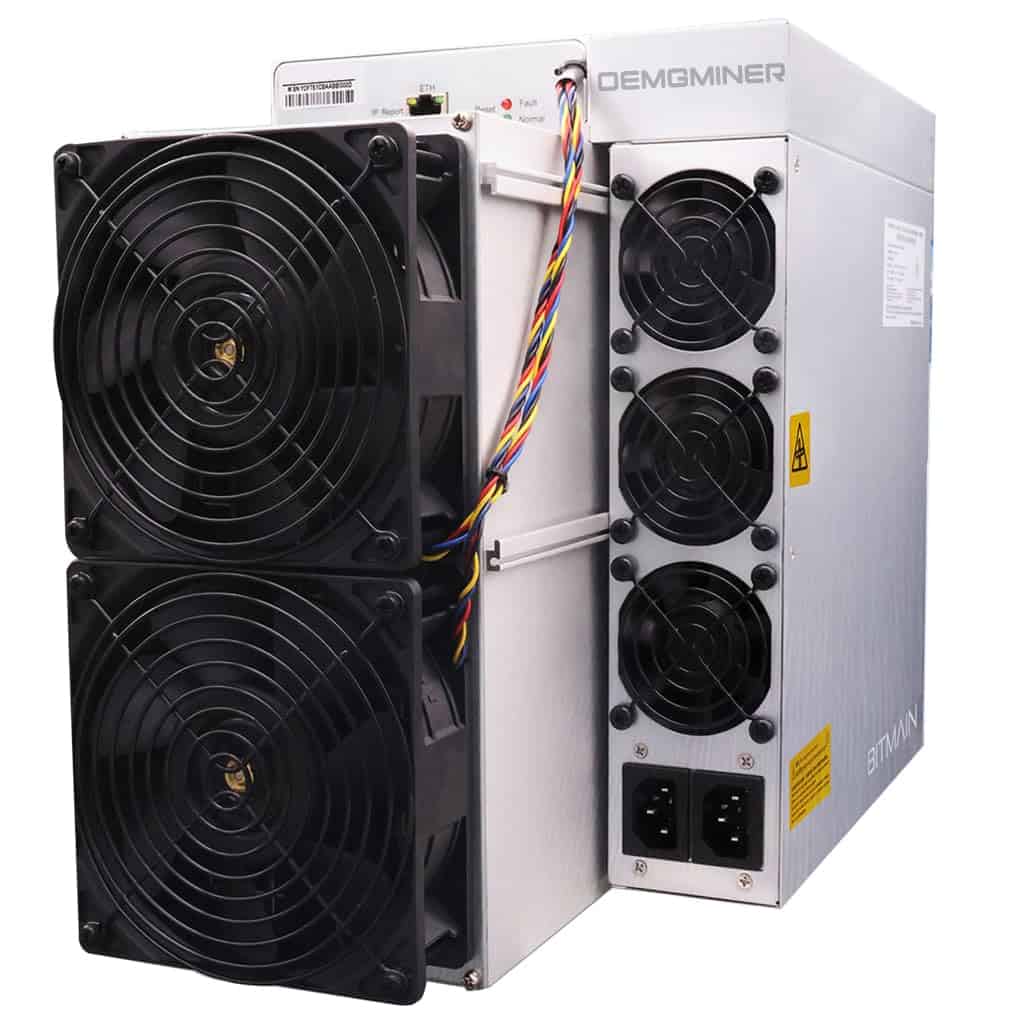
The Antminer S19k Pro provides excellent hash rates with energy-efficient operation, making it a solid investment for serious Bitcoin miners despite its high power requirements.
Pros
- Impressive 120 TH/s computing power speeds up Bitcoin returns
- Energy-efficient 23W/TH ratio saves on electricity costs
- Includes 1-year warranty with technical support
Cons
- Requires 220V power (US users need a transformer)
- High initial investment cost
- Generates significant heat and noise
This ASIC Bitcoin miner stands out in the cryptocurrency mining market. With 120 TH/s of computing power, it processes Bitcoin algorithms much faster than many competitors. The miner features Bitmain’s original chips and enhanced cooling systems that help it run continuously with minimal failure rates.
Energy costs often make or break mining profitability. The S19k Pro addresses this challenge with its 23W/TH energy consumption ratio. At 2760W total power draw, it uses about 30% less electricity than similar miners. This efficiency can save thousands in power costs over the machine’s lifetime.
Setup requires some technical knowledge. The unit needs 220V power, which means US-based miners must buy a separate transformer since standard US outlets provide 110V. The package includes the power supply unit, saving buyers from making an additional purchase. Proper cooling is essential as these machines generate substantial heat during operation.
Lucky Miner LV08 Solo Bitcoins Miner

The Lucky Miner LV08 combines powerful mining capabilities with home-friendly features, making it a solid option for beginners entering the cryptocurrency mining space.
Pros
- High hash rate of 4-5TH/s with advanced 5nm ASIC chip
- Supports multiple cryptocurrencies using SHA-256 algorithm
- Low noise and power consumption ideal for home use
Cons
- Limited to SHA-256 cryptocurrencies only
- SOLO mining focus may yield less consistent returns
- WiFi limited to 2.4GHz band
The LV08 from Lucky Miner stands out with its BM1366 ASIC chip that delivers between 4000-5000 GH/s hash rate. This compact device aims to make crypto mining accessible for home users without the industrial-scale setup typically needed for profitable mining operations.
Users will appreciate the device’s ability to mine multiple cryptocurrencies based on the SHA-256 algorithm. Beyond Bitcoin, it works with BCH, BSV, DGB, and dozens of other coins. The flexibility lets miners adjust their strategy based on market conditions or personal preference.
The miner features built-in 2.4G WiFi connectivity for easy setup and monitoring. This wireless capability eliminates complicated wiring operations and allows users to manage their mining activities remotely. The compact size (5.1 x 2.76 x 7.9 inches) and quiet operation make it suitable for placement in living spaces.
Lucky Miner markets the LV08 primarily as a “lottery miner” with SOLO mining mode. In this configuration, miners have a chance to win full block rewards (currently 3.125 BTC) when they successfully mine a block. This approach differs from pool mining, where rewards are shared but come more frequently.
Antminer L3+ Scrypt Miner
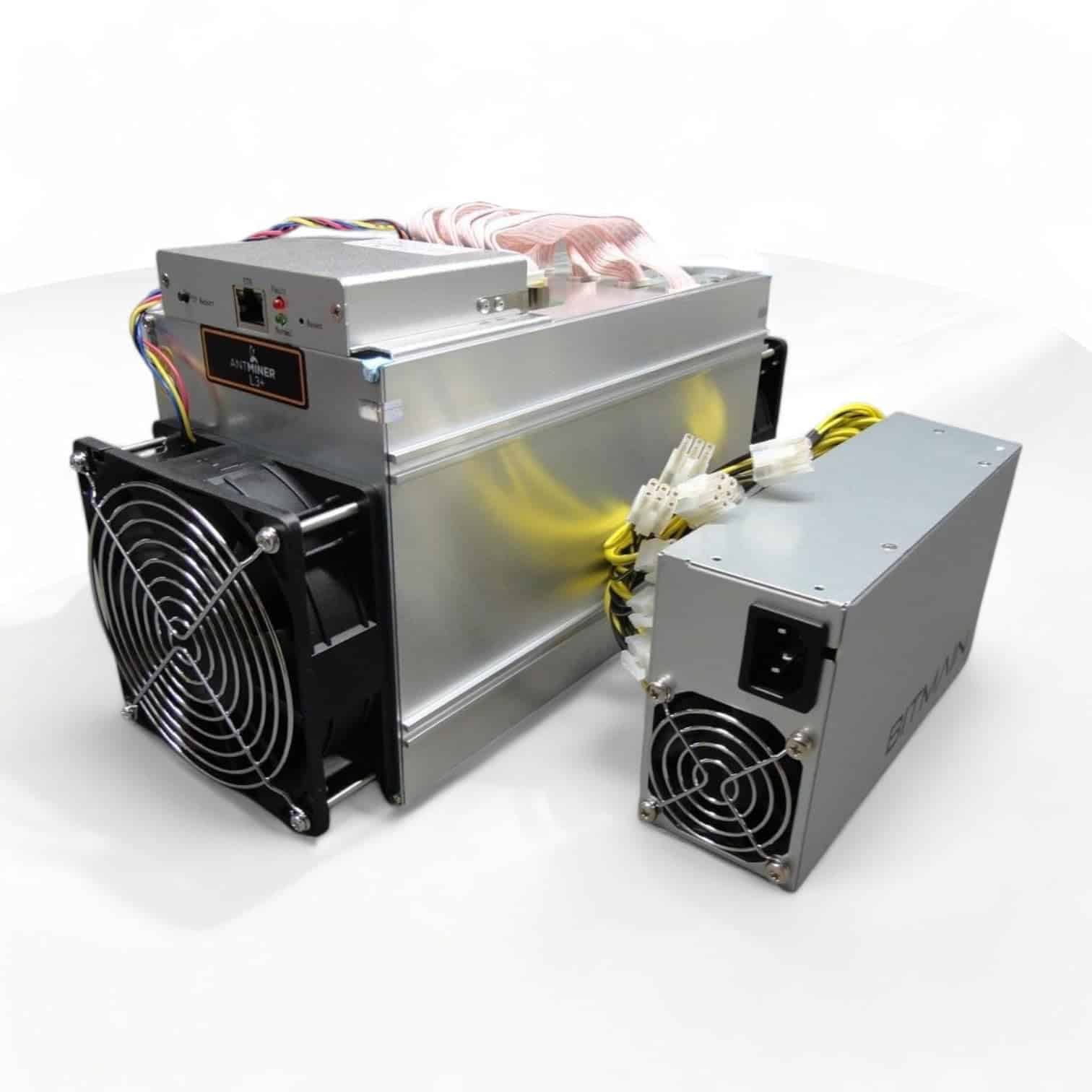
The Antminer L3+ with VNish firmware offers an excellent balance of power efficiency and mining performance that makes it a smart choice for both beginners and experienced crypto miners.
Pros
- Energy-efficient at 600W with 504MH/s+ hashrate
- Customizable settings for power use and performance
- Quieter operation than standard miners
Cons
- Initial investment cost
- Requires technical knowledge for optimization
- Mining profitability fluctuates with crypto markets
This miner stands out for its impressive efficiency. The pre-installed VNish firmware reduces power consumption to just 600W while maintaining a solid 504MH/s+ hashrate. Users can tune settings to save even more power or push performance up to 650MH/s depending on their goals.
Energy costs are a major concern for crypto miners. At 1.2 J/MH efficiency, this unit uses significantly less electricity than standard L3+ setups. The power savings translate directly to better profits and less heat generation, making it suitable for home mining setups.
The plug-and-play design works with all major mining pools. Setup takes minutes rather than hours, and the optimized dashboard makes it easy to monitor performance. It’s compatible with NiceHash, LitecoinPool, F2Pool, and other popular mining services.
Heat and noise are minimal compared to other miners. The VNish firmware improves cooling efficiency while reducing fan noise. This makes the unit practical for home use in garages, basements or even apartments without disturbing others.
The compact size (352mm x 130mm x 187.5mm) helps it fit in small spaces. It works with standard power supplies on both 110V and 220V connections. The hardware’s durability is enhanced by the firmware’s optimization, which reduces stress on components and extends the miner’s lifespan.
Mining Litecoin, Dogecoin, and other Scrypt-based cryptocurrencies becomes more accessible with this unit. The combination of Bitmain quality hardware and VNish firmware creates a reliable mining solution for both newcomers and experienced crypto miners.
Lucky Miner Bitcoin Solo Miner
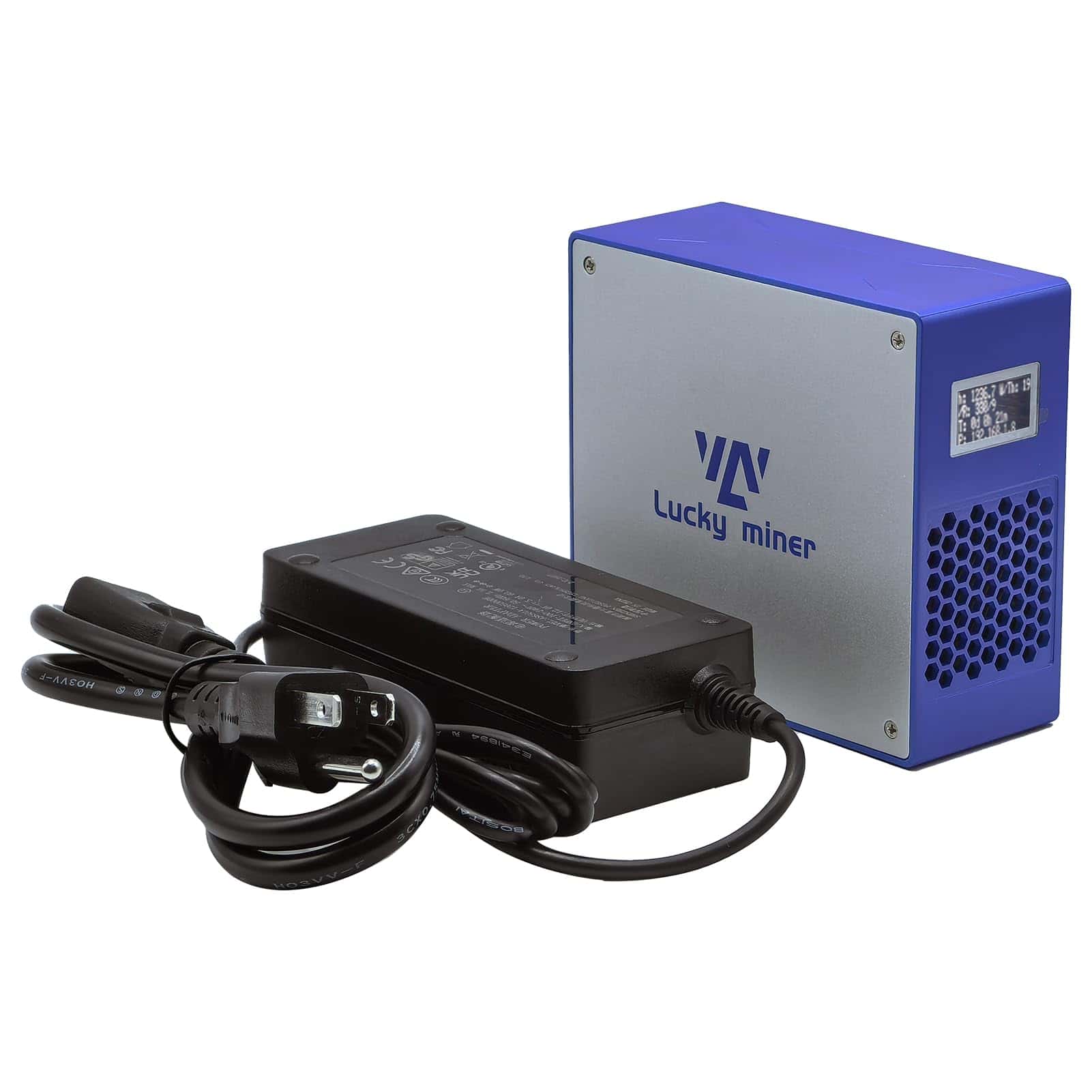
The Lucky Miner LV07 offers decent cryptocurrency mining capabilities for home users seeking a low-power, quiet mining solution, though its solo mining focus means uncertain returns.
Pros
- Advanced 5nm ASIC chip with 0.9-1.1 TH/s hash rate
- Low power consumption at only 25 watts
- Built-in WiFi for easy setup and monitoring
Cons
- Limited hash power compared to professional miners
- Solo mining focus with lottery-like payouts
- Setup may confuse beginners without clear instructions
This compact Bitcoin miner measures just 4.13 × 2.36 × 1.3 inches, making it easy to place in a home environment. The device uses the BM1366 ASIC chip architecture with a hash rate between 900GH/s to 1.1TH/s. Users won’t need to worry about excessive noise or power bills since it runs at just 25 watts and features quiet cooling technology.
Setup requires connecting to a 2.4GHz WiFi network, which eliminates messy wiring. The miner supports multiple SHA-256 cryptocurrencies including Bitcoin, Bitcoin Cash, and about 42 others. Most buyers will appreciate the wireless connectivity, but some reviews indicate the instructions could be clearer for newcomers to crypto mining.
The device primarily functions as a “lottery miner” in SOLO mode, where users independently try to solve blocks for full rewards. This approach means potentially winning 3.125 BTC when successful, but chances are slim compared to pool mining. The unit also supports other mining modes like PPLNS, PPS, and PROP for those preferring more consistent but smaller rewards through mining pools.
Bitaxe Gamma Bitcoin Miner

The Bitaxe Gamma offers an accessible entry into Bitcoin mining with its efficient BM1370 chip and user-friendly interface, making it ideal for home miners seeking an open-source solution.
Pros
- Impressive 1.2TH/s hashrate with excellent 14J/TH energy efficiency
- Complete open-source design gives users full control over mining operations
- Simple setup and monitoring through intuitive web interface
Cons
- Limited to 2.4GHz WiFi networks only
- Requires specific 5V/6A power supply
- Higher initial investment compared to other entry-level miners
The Bitaxe Gamma stands out as a compact Bitcoin mining solution for home users. It uses the same BM1370 ASIC chip found in the professional Antminer S21 Pro models. This tiny miner delivers approximately 1.2TH/s of mining power while maintaining an impressive efficiency rating of 14J/TH.
Power requirements are modest compared to industrial miners. The unit needs only a 5V DC power supply that can deliver at least 6 amps through a standard barrel connector. This makes it much more practical for home use than larger miners that require special power setups.
Setting up the Bitaxe is straightforward for most users. The miner connects via 2.4GHz WiFi networks and features the open-source AxeOS firmware. The built-in web portal allows miners to monitor performance, adjust settings, and update firmware without needing advanced technical skills.
What makes this miner special is its fully open-source nature. Both the hardware design and software are open for users to modify. This transparency gives miners complete control over their equipment, unlike closed proprietary systems from many manufacturers.
The device itself is compact, measuring just 3.3 x 2.4 x 5.2 inches and weighing about 500 grams. Its small size and relatively quiet operation make it suitable for home environments where noise and space might be concerns.
VTRETU 8GPU Mining Rig
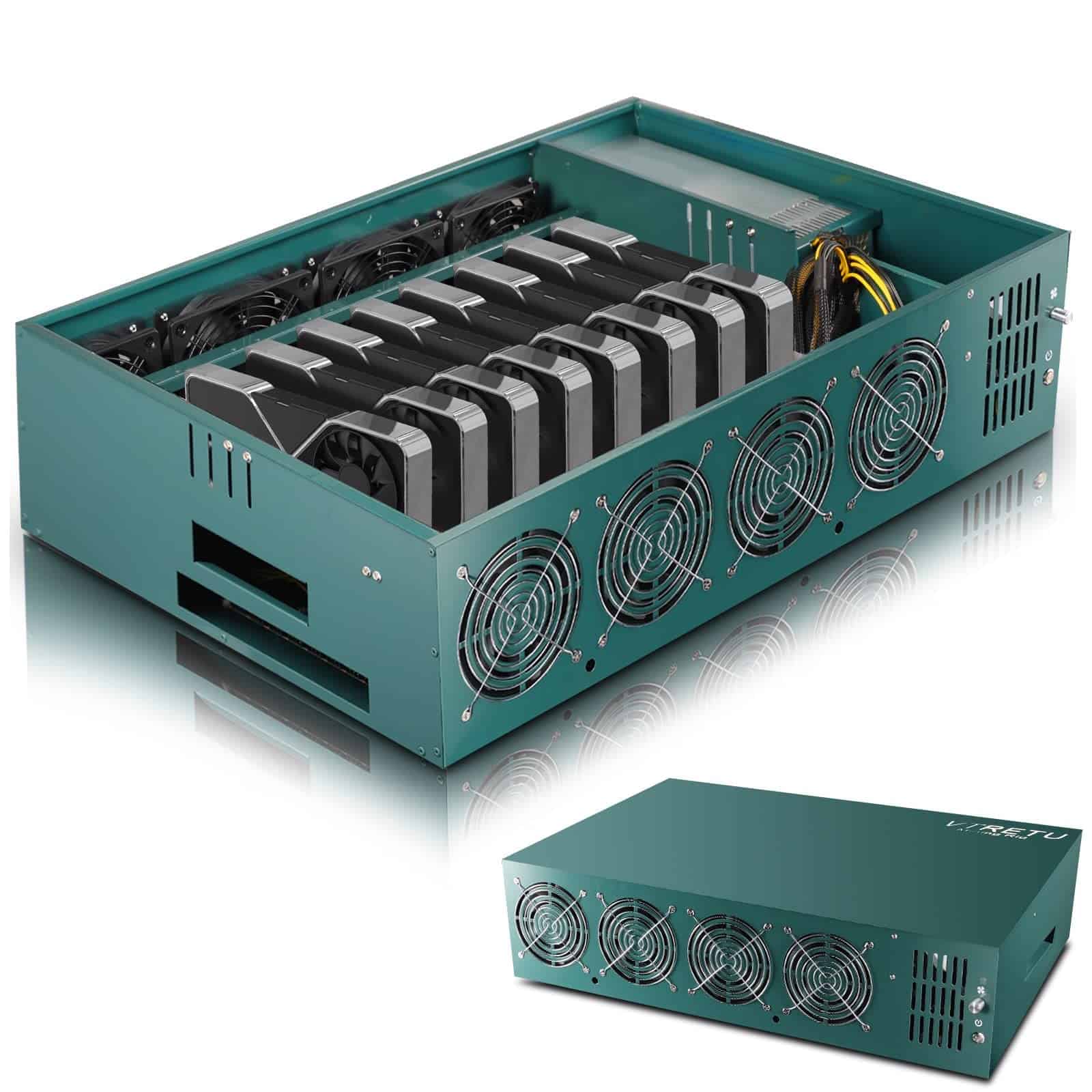
This mining rig offers a solid foundation for crypto mining enthusiasts with its complete package and easy setup, though the average rating suggests some performance limitations.
Pros
- Complete setup with everything except GPUs
- Quick installation with pre-installed Windows 10
- Powerful 2000W power supply handles multiple GPUs
Cons
- Loud cooling fans can be disruptive
- Some users report reliability issues
- Motherboard may struggle with demanding mining software
The VTRETU mining rig comes as a nearly complete package for crypto enthusiasts. Users receive an 8GPU mining motherboard, 2000W power supply, 4GB RAM, and Intel Celeron CPU with cooling system. The steel frame construction offers durability while protecting valuable components. Miners only need to add their choice of GPUs to begin operations.
Setup simplicity stands out as a major advantage. The pre-installed Windows 10 operating system means less configuration time and faster mining startup. Four USB ports, VGA and LAN connections provide plenty of options for peripherals and network connectivity. The included VGA adapter cable and GPU mounting hardware streamline the installation process.
Cooling performance receives mixed reviews from users. Eight controllable fans (four on each side) create good airflow, but several customers mention excessive noise levels. The adjustable fan speed controller helps balance cooling needs with noise concerns. For serious miners, placing this rig in a dedicated space away from living areas might be necessary due to the sound levels during operation.
Memory and storage specifications meet basic requirements but aren’t exceptional. The system includes 4GB DDR3 RAM running at 1600 MHz and a solid state drive for storage. These components provide adequate performance for most mining applications, though more demanding software might benefit from RAM upgrades.
User experiences vary widely with this product. Some report excellent reliability and ease of use, while others mention compatibility issues with newer GPUs or system crashes under heavy loads. The 3.7-star rating reflects this mixed performance. New miners will appreciate the comprehensive package, but experienced users might want more robust components for long-term, intensive mining operations.
Cryptocurrency Mining Guide

This beginner’s guide offers a solid introduction to cryptocurrency mining basics, though it lacks detailed technical instructions for setting up mining equipment.
Pros
- Clear explanations of mining concepts
- Covers multiple cryptocurrencies
- Includes profitability calculations
Cons
- Basic information readily available online
- Contains grammar and spelling errors
- Somewhat outdated information
The book provides a quick overview of cryptocurrency mining fundamentals. Readers can finish it in one sitting while gaining knowledge about Bitcoin, Litecoin, Ethereum, and other popular cryptocurrencies. The author explains the mining process in simple terms that newcomers can understand.
Many reviewers appreciate how the guide handles profitability calculations. This helps potential miners determine if the investment is worthwhile before spending money on equipment. The book avoids overly technical language, making it accessible for readers without technology backgrounds.
Some weaknesses appear in the editing quality. Several readers noted spelling and grammar issues throughout the text. The information also doesn’t go deep enough for readers who want step-by-step instructions on building mining rigs. At 104 pages, this paperback serves as an entry point rather than a comprehensive resource.
First-time miners might find value in understanding basic concepts before diving deeper. The book explains mining fundamentals, hardware considerations, and the economics behind cryptocurrency mining. For readers wanting more detailed technical guidance, additional resources will be necessary.
BeLuckyMan LV08 Bitcoin Miner

The BeLuckyMan LV08 offers a decent entry point for home crypto mining with its balance of performance and low power consumption.
Pros
- Advanced 5nm BM1366 ASIC chip with 4-5 TH/s hashrate
- Supports 42+ cryptocurrencies using SHA-256 algorithm
- Built-in WiFi for easy setup and remote monitoring
Cons
- Limited to SHA-256 cryptocurrencies only
- Lower hashrate compared to industrial miners
- May still increase electricity bills despite “low power” claims
This compact mining device fits easily in home environments without creating excessive noise or taking up much space. Its dimensions of just 7.9 x 5.1 x 2.76 inches make it suitable for desktops or small shelves. The blue casing gives it a less industrial look than many mining rigs.
Users appreciate the wireless connectivity options. The built-in 2.4GHz WiFi module lets miners monitor and manage their operation remotely without messy cable setups. This feature is helpful for people who want to check mining progress or make adjustments without physically accessing the device.
The LV08 supports multiple mining modes including SOLO, PPLNS, PPS, and PROP. This flexibility allows miners to choose the best strategy based on their goals and risk tolerance. New miners might prefer the steady payouts of PPS mode, while more experienced users can opt for SOLO mining when seeking larger but less frequent rewards.
Bitcoin Mining, 2022. https://www.amazon.com/BeLuckyMan-Bitcoins-Machine-Portable-Cryptocurrency/dp/B0DQPWX4WV?tag=pc05c0-20
ASRock H110 Pro BTC+ Mining Motherboard

The ASRock H110 Pro BTC+ stands out as a solid investment for serious crypto miners thanks to its exceptional capacity to support up to 13 GPUs simultaneously.
Pros
- Supports an impressive 13 GPUs for maximum mining power
- Compatible with 6th and 7th generation Intel processors
- Reliable performance for 24/7 mining operations
Cons
- Some users report compatibility issues with certain GPU combinations
- Setup can be challenging for beginners
- May require specific BIOS settings to work properly
This specialized motherboard was designed with cryptocurrency miners in mind. The standout feature is its ability to connect up to 13 GPUs, which puts it far ahead of standard motherboards. Built on Intel’s H110 chipset, it supports DDR4 memory with speeds up to 2400 MHz.
Connectivity options abound with this board. It includes 1 PCIe 3.0 x16 slot and 12 PCIe 2.0 x1 slots for all your mining cards. The board also offers 4 SATA3 ports and an M.2 slot for storage options. This level of expansion is rare in the mining motherboard market.
User experiences vary with the ASRock H110 Pro BTC+. Many miners report smooth operation with multiple GPUs running 24/7 without issues. Some users have successfully run all 13 slots with various graphics cards. Others mention they could only get 6-8 GPUs working stably. The board seems to perform best when users take time to properly configure BIOS settings and ensure adequate power supply.
For beginners entering the mining world, this motherboard offers room to grow. Start with a few GPUs and add more as your operation expands. The board’s Super Alloy construction helps with durability during constant use. With proper setup and cooling, miners can create a powerful rig that handles the demands of cryptocurrency mining.
Bomeiqee Mining Rig Frame

The Bomeiqee 12GPU Mining Rig Frame offers excellent value for crypto miners seeking a sturdy, well-designed open-air case to organize their mining setup.
Pros
- Strong stainless steel construction provides durability
- Supports up to 12 GPUs with dual power supply options
- Enhanced cooling design with space for eight 120mm fans
Cons
- Assembly instructions could be clearer
- Some users report missing hardware components
- Actual GPU capacity may be reduced when using power supplies
This mining frame stands out with its robust stainless steel construction. The open-air design helps with heat dissipation, a crucial factor for mining rigs that run continuously. Users can mount up to 12 GPUs, though practical capacity might be slightly less when accounting for power supplies.
Assembly requires some patience. The included instructions feature small images that some users found difficult to follow. However, most buyers report completing the build within 30-60 minutes using basic problem-solving skills. The package includes necessary mounting hardware such as hexagonal columns, motherboard screws, and non-slip rubber pads.
The frame accommodates two ATX power supplies up to 24cm in length. This dual PSU support is valuable for powering multiple high-end GPUs. The design includes dedicated spaces for storage devices (one SSD and one HDD) and provides room for a CPU cooler up to 135mm in height. At 5kg shipping weight, the frame offers a good balance of sturdiness and manageability for home mining enthusiasts.
Goldshell AL Box II Plus Miner

The Goldshell AL Box II Plus offers a solid entry point for home-based Alephium mining with its quiet operation and user-friendly design.
Pros
- Quiet operation perfect for home environments
- Simple setup process for beginners
- Energy-efficient at 480 watts
Cons
- Limited to mining only Alephium cryptocurrency
- Higher initial investment than GPU options
- Single fan cooling may limit overclocking potential
This compact mining device measures just 5.91 x 3.43 x 7.8 inches, making it easy to place in a home office or other living space. The unit delivers 1TH (terahash) of mining power while consuming 480 watts, striking a reasonable balance between performance and energy usage. Users appreciate that it comes with the power supply unit included, eliminating the need for additional purchases.
Noise levels remain minimal thanks to the cooling system design. This feature sets it apart from many competing miners that sound like jet engines during operation. The manufacturer focused on creating a solution that works well in residential settings where loud equipment would cause problems.
Setup takes minutes rather than hours with this device. Even beginners can start mining Alephium quickly after unboxing. The miner works best in spaces with decent airflow to prevent overheating during extended operation. For those entering crypto mining for the first time, this OEMGMINER product offers a more accessible starting point than complex custom rigs that require technical knowledge to assemble and optimize.
KIVLING LV07 Bitcoin Miner

The KIVLING LV07 offers an entry-level mining experience with a small hash rate that makes it better suited for hobbyists than serious miners looking for significant returns.
Pros
- Very low power consumption at only 25W
- Quiet operation under 35dB for comfortable home use
- Simple plug-and-play setup process with WiFi connectivity
Cons
- Limited 1TH/s hash rate severely restricts earning potential
- Some users report overheating issues
- Setup software receives mixed reviews for reliability
The LV07 Bitcoin Miner from KIVLING presents itself as a compact option for beginners. This small unit measures just 200 x 180 x 65 inches and weighs only 2.2 pounds, making it easy to place anywhere in a home. It uses a 5nm ASIC chip technology that helps it achieve its modest 1TH/s hash rate while keeping power consumption down to just 25 watts.
Setup follows a straightforward process. Users connect the device to an AC outlet and configure it through WiFi. The system works with both computers and mobile devices for monitoring. This plug-and-play approach aims to remove technical barriers that often prevent newcomers from trying cryptocurrency mining.
The device supports multiple cryptocurrencies using the SHA-256 algorithm. These include Bitcoin Cash (BCH), Bitcoin SV (BSV), and DigiByte (DGB), with support for up to 42 different types in total. Mining modes include SOLO, PPLNS, PPS, and PROP to match different strategies. While user reviews vary widely, most success stories come from those using it as a learning tool rather than expecting significant profits.
Mining enthusiasts should note the extremely low hash rate compared to industrial miners. The 1TH/s capacity means this device functions more as an educational tool than a serious income generator. It launched in July 2024 and represents an accessible starting point for those curious about crypto mining without major investment.
Bitcoin Mining Guide

This beginner’s guide to cryptocurrency mining offers clear instructions for newcomers who want to earn passive income from Bitcoin and other digital currencies.
Pros
- Explains complex concepts in simple terms
- Provides practical steps for setting up mining operations
- Covers multiple cryptocurrencies beyond just Bitcoin
Cons
- Some information may become outdated as crypto technology evolves
- Doesn’t address all environmental concerns of mining
- Limited coverage of advanced mining techniques
The book breaks down the often confusing world of cryptocurrency mining into manageable parts. Readers learn about blockchain technology and how mining fits into the larger crypto ecosystem. The author takes care to explain technical terms without assuming prior knowledge.
Setting up a mining operation requires specific hardware and software. This guide walks beginners through equipment selection, from using a basic gaming computer to building dedicated mining rigs. It also explains mining pools where individuals combine their computing power to increase chances of earning rewards.
Profitability calculations receive significant attention in the text. The book helps readers understand electricity costs, hardware expenses, and potential returns. At 136 pages, it’s a concise resource that covers essential information without overwhelming new miners. For anyone curious about earning passive income through cryptocurrency mining, this guide provides a solid foundation.
TANGEM Wallet Pack
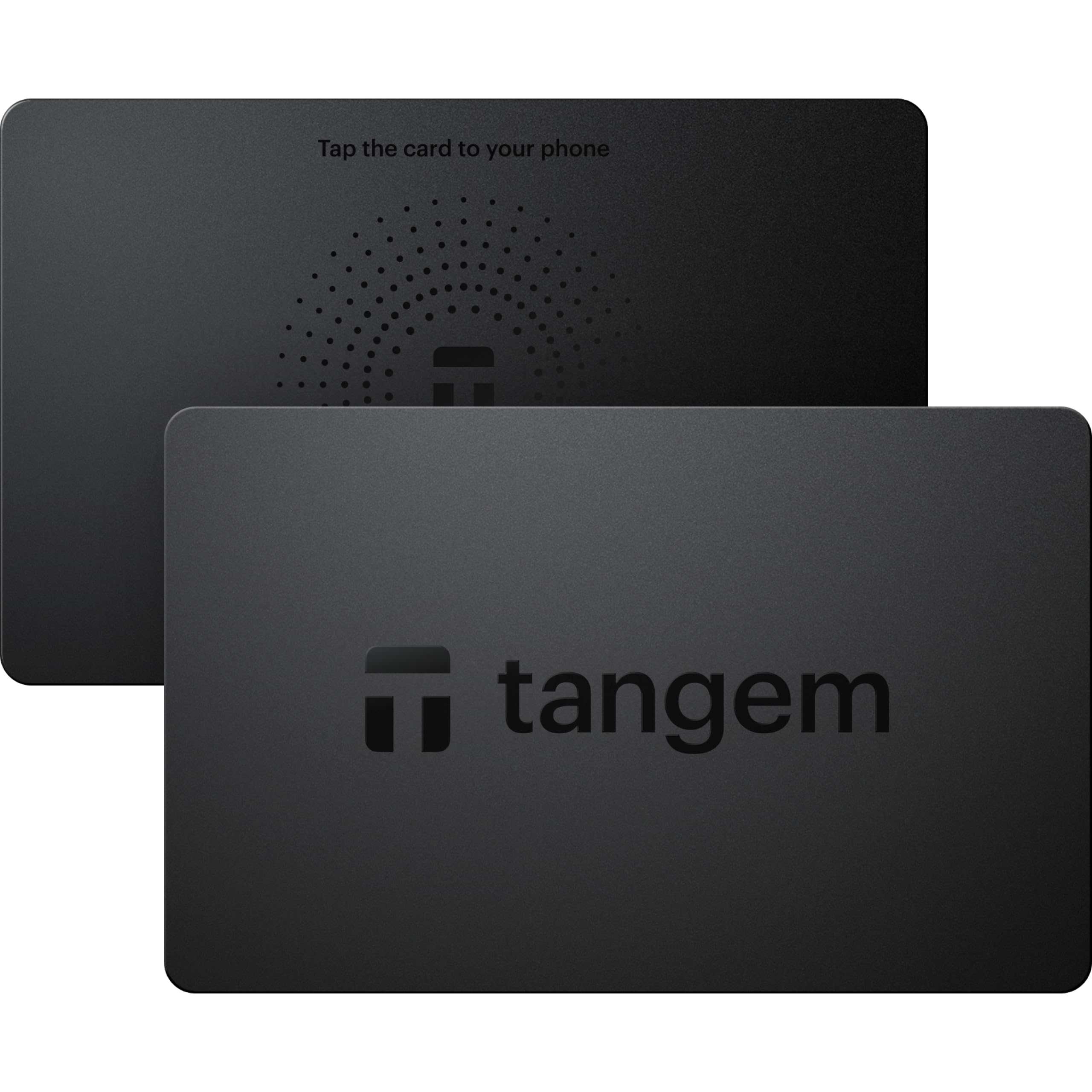
The TANGEM Wallet Pack offers top-tier security for crypto assets with an impressive EAL6+ certification, making it a smart choice for both beginners and experienced crypto investors.
Pros
- High-level security with private keys that never leave the card
- Works with 13,000+ tokens across 70+ blockchains
- Simple tap-to-use design with no computers needed
Cons
- Requires a phone with NFC capability
- Higher price point than some software wallets
- Limited physical durability despite IP68 rating
The TANGEM Wallet comes in a pack of two cards that act as cold storage for cryptocurrencies. Users can store Bitcoin, Ethereum, and thousands of other tokens securely offline. The wallet generates private keys directly on the card, where they remain protected from online threats.
Setting up is straightforward – just tap the card on your phone and install the TANGEM app. The system uses NFC technology to connect, eliminating cables, Bluetooth, or USB connections that might create security vulnerabilities. This wallet bridges the gap between convenient hot wallets and secure cold storage.
One standout feature is the backup system. The second card serves as a backup, removing the need to write down seed phrases on paper. TANGEM also offers a 25-year warranty, which shows confidence in their product quality. The cards support buying crypto with Apple Pay or credit cards and selling back to fiat currency when needed.
The wallet has earned recognition from security labs like Kudelski Security and Riscure. These certifications matter because they verify the wallet can resist sophisticated hacking attempts. For someone serious about crypto security but wanting something more convenient than traditional hardware wallets, the TANGEM cards offer a compelling solution.
Buying Guide
Choosing the right crypto mining equipment is crucial for success. This guide will help you make informed decisions when purchasing mining hardware.
Hash Rate
Hash rate measures how quickly a mining device can solve complex equations. Higher hash rates mean more mining power.
| Hash Rate Level | Expected Performance |
|---|---|
| Low (10-30 TH/s) | Entry-level mining |
| Medium (30-90 TH/s) | Intermediate mining |
| High (90+ TH/s) | Professional mining |
A good hash rate is essential for profitability in crypto mining.
Energy Efficiency
Power consumption directly affects mining profits. Look for devices with low watts per terahash (W/TH) ratios.
Energy-efficient miners cost less to operate. This factor becomes even more important in areas with high electricity costs.
Initial Investment
Mining equipment prices vary widely based on performance. Balance upfront costs against potential returns.
Budget miners can start with used equipment, while serious miners might invest in new, high-performance machines.
Cooling Requirements
Mining generates significant heat. Proper cooling systems are necessary to prevent overheating and hardware damage.
Consider the noise level of cooling systems, especially for home setups. Some miners run very loud and may not be suitable for residential areas.
Compatibility
Different cryptocurrencies require specific mining hardware. ASIC miners work for specific algorithms, while GPUs offer more flexibility.
Make sure your hardware matches the cryptocurrency you plan to mine.
Frequently Asked Questions
Crypto mining involves several complex processes, financial considerations, and technical requirements. These questions address the most common concerns from newcomers and experienced miners alike.
What is the process involved in mining cryptocurrency?
Cryptocurrency mining is a process where computers solve complex mathematical problems to verify transactions. These problems require significant computing power to solve. When a miner successfully solves a problem, they add a new block to the blockchain.
The mining process starts when transactions are grouped into a block. Miners then compete to find a specific value that, when hashed with the block data, produces a result meeting certain criteria. This is called proof-of-work.
Once a miner finds the solution, they broadcast it to the network. Other miners verify the solution, and the block gets added to the blockchain. The successful miner receives a reward in the form of new coins and transaction fees.
How can one calculate the profitability of cryptocurrency mining?
Mining profitability depends on several key factors. These include electricity costs, hardware expenses, mining difficulty, and cryptocurrency prices. Various online calculators can help estimate potential earnings.
The basic formula considers: (Value of mined coins) – (Electricity costs + Hardware costs) = Profit. Hardware costs should be calculated as a daily amortization of the initial investment over its expected lifespan.
Mining difficulty increases over time as more miners join the network. This means the same hardware will earn fewer coins as time passes. Market volatility also affects profitability, as cryptocurrency prices can change dramatically.
What are the legal considerations surrounding cryptocurrency mining?
The legal status of cryptocurrency mining varies by country. Some nations fully embrace mining activities, while others have implemented restrictions or complete bans. Miners must research local regulations before starting operations.
Tax obligations represent another important legal consideration. Mining rewards are typically taxable income in most jurisdictions. Miners must keep detailed records of their earnings and expenses for tax reporting.
Energy regulations may also affect mining operations. Some regions have specific rules about power consumption for commercial activities or may charge different rates for industrial power usage.
What equipment is required to start mining cryptocurrency?
Mining equipment varies based on the cryptocurrency being mined. For Bitcoin and many others, specialized hardware called ASICs (Application-Specific Integrated Circuits) provides the best performance and efficiency.
For coins like Ethereum (prior to its proof-of-stake transition), powerful graphics cards (GPUs) were the preferred choice. Some newer cryptocurrencies can still be mined with GPUs or even regular computer processors.
Additional essential equipment includes a stable internet connection, power supplies, cooling systems, and mining software. Large operations may need industrial power setups and temperature control systems to maximize efficiency.
Can an individual participate in cryptocurrency mining without investing money?
Mining without investment is challenging but possible through several methods. Cloud mining services allow users to rent mining power without buying hardware, though these often require subscription fees.
Mining pools let individuals combine their computing resources with others. While this requires some hardware, joining a pool allows miners with modest equipment to earn partial rewards more consistently.
Some websites offer browser-based mining, where users can mine small amounts of cryptocurrency while visiting the site. The returns are typically very low but require no initial investment beyond having a computer.
How much time is generally needed to mine a certain amount of cryptocurrency?
Mining time varies significantly based on several factors. Network difficulty, mining hardware power, and luck all play important roles in determining mining success rates.
For Bitcoin, an individual miner with a single modern ASIC might take years to mine a complete block. This is why most miners join pools to receive smaller, more frequent payouts based on their contributed computing power.
Smaller cryptocurrencies with lower mining difficulty might yield faster results. Some miners can earn small amounts within hours or days when mining alternative coins with less competition.




